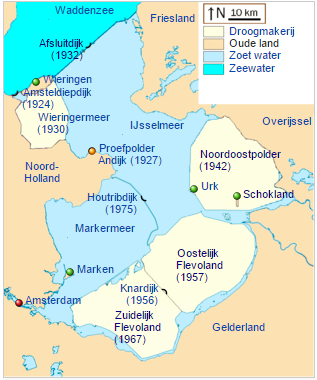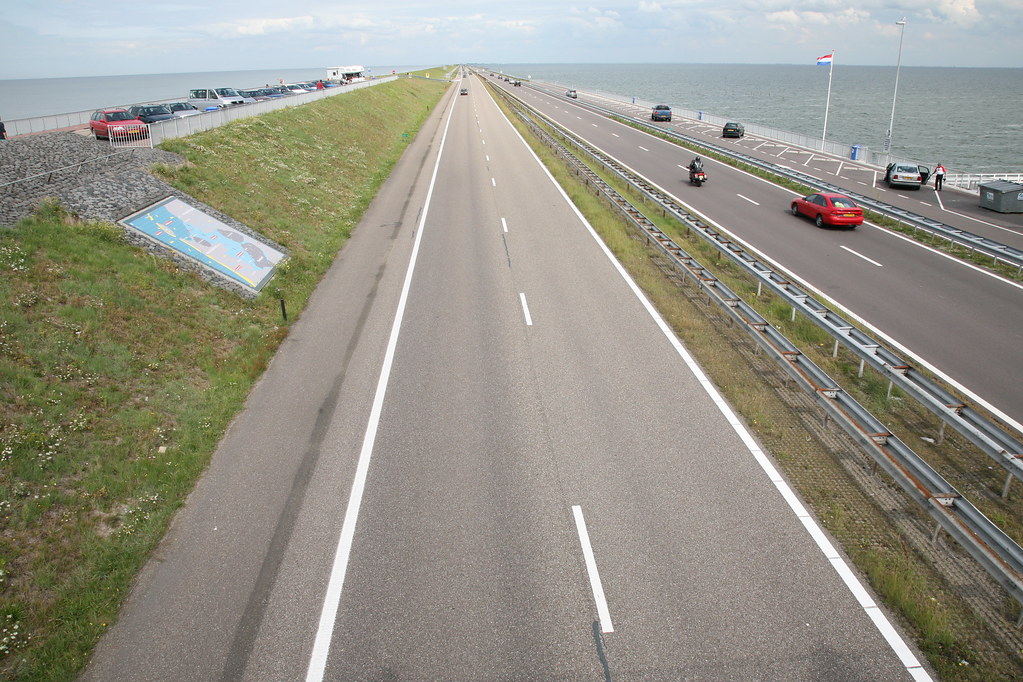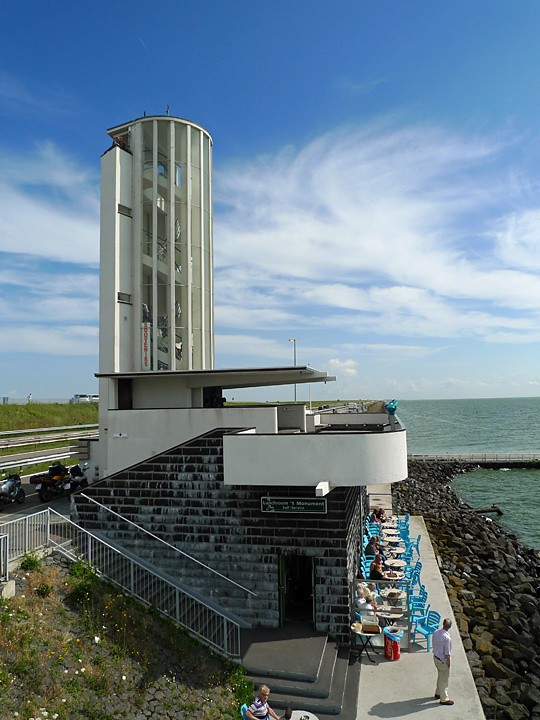De Afsluitdijk – Enclosing the Sea Posted by Sten on Oct 26, 2015 in Culture
So, last week, I wrote about the Zuiderzeewerken, which gave birth to the province Flevoland. But not only that.

As you can see, the Afsluitdijk was finished in 1932, after which there was space for the creation of Flevoland. (Image by Io Herodotus at Commons.wikipedia.org)
The Zuiderzeewerken had as their goal to create more land for agricultural use, and to “tame” the Zuiderzee, the part of the Noordzee (North Sea) that protruded well into the Dutch inland. Another goal, which was pursued already centuries before the proposal of the Zuiderzeewerken at the end of the 1800s, was to stop the frequent floods and devastation the Zuiderzee would cause through its influence of the Noordzee.
The Dutch wanted to regulate this better. And one of the first, and probably the most important way to do this was the Afsluitdijk. The name literally means the “Lock Dyke”, since it locks up the Zuiderzee, away from its parent, the Noordzee. The name dijk is not entirely accurate – a dijk refers to a separation between water and land, whereas the Afsluitdijk separates two waters – making it a dam. The accurate name would therefore be Afsluitdam!
Whatever its name, the 32 km (almost 20 mi) long road on the dam, which itself is actually 30 km (almost 19 mi) long. This closure was built from 1927-1932: a remarkable feat for its time! So the question that comes up, of course, is:
How did they do it?
First, in 1920, the Amsteldiepdijk or Korte Afsluitdijk was built, which served as a model and try-out for the real deal. This dijk was only 2.5 km (1.5 mi) long, and was connected Noord-Holland to the island Wieringen. The experience made in this short project was later used in the construction of the Afsluitdijk.
That construction started in 1927. The Afsluitdijk was built from four locations: from the coastal line in Noord-Holland at Den Oever, from the coastal line in Friesland at Zurich, from Breezand, and from Kornwederzand. Breezand and Kornwederzand were both werkeilanden (work islands), which were built on the track of the Afsluitdijk.
As a foundation, wilgtenen were used – willow rods. These were sunk by placing stone blocks on top of them. Now I bet you think: wood? How is that supposed to withstand all that water force for decades? Well, it didn’t. Already in 1931, it became clear that the wood was infected with paalworm, a parasite that makes the wood hollow, and the steel rods that kept the wood together was already strongly affected by the sea. German baryte was used as a replacement, a strong mineral that withstands water very well.
Keileem (boulder clay) was used for the first time in the Afsluitdijk, because it was deemed stronger than sand or clay. Together with sand and stones, keileem formed the body of the dijk.
Two, and later three, sluizen (locks) were inserted into the dijk to regulate the water in the IJsselmeer, since rivers would still increase the amount of water in it.
On this dijk, a road was built, and that basically completed the work in 1932. On September 20 of that year, the Zuiderzee officially became the IJsselmeer.
Success
The first noticeable success of the Afsluitdijk was in 1953, when the Watersnoodramp struck. It withstood the high water, and saved a lot of lives and disaster around the IJsselmeer.
Criticism
Back in the days of its construction, fishermen were complaining, because the fishery in the Zuiderzee would end with the Afsluitdijk. However, their protest was not enough, and it was built anyway. A small poem was left, that described this:
Eerst de zee en nu de netten
nam men van de Urkers af
En zoo delft men, schop voor schopje
langzaam aan des visschers graf.
Do you understand what it says? Let me know in the comments!
Visiting the Afsluitdijk
You can also visit the Afsluitdijk, climb the uitkijktoren (observation tower) and see the dam from up high, and take nice pictures like the one above. This Monument op de Afsluitdijk was built in 1933 at the Vlieter, where the Afsluitdijk was closed in 1932.
Have you been to the Afsluitdijk before?
Are there similar spectacular constructions in your country?

Build vocabulary, practice pronunciation, and more with Transparent Language Online. Available anytime, anywhere, on any device.
About the Author: Sten
Hi! I am Sten, both Dutch and German. For many years, I've written for the German and the Dutch blogs with a passion for everything related to language and culture. It's fascinating to reflect on my own culture, and in the process allow our readers to learn more about it! Besides blogging, I am a German-Dutch-English translator, animator and filmmaker.






Comments:
Errol:
Hi Sten
Wonderful article about the Afsluitdijk. I was there (way back in 1966) and found it fantastically impressive.
I like the poem (understand it well)(I’m South African and speak Afrikaans), except the “Urkers”. The fishermen in one of the villages?
Cheers,
Errol
Sten:
@Errol Thnk you, Errol!
Yes, the “Urkers” are the inhabitants of the former island “Urk”, which is now a village in the Noordoostpolder in Flevoland. As it was in the middle of the Zuiderzee, there were of course a lot of fishers in Urk!
Jan:
Eerst de zee en nu de netten
(first the sea and now the nets)
nam men van de Urkers af
(were taken from the Urkers (inhabitants of Urk))
En zoo delft men, schop voor schopje
(this way they dig, shovel by shovel)
langzaam aan des visschers graf.
(slowly the fishermens grave)
It is written in a slightly dated dutch language
I live in Bolsward, Friesland about 10 Km from the afsluitdijk.
So I should know :).